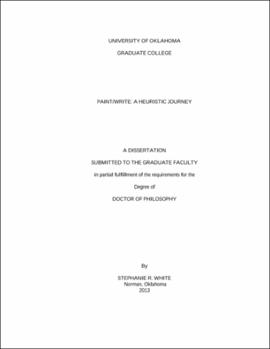| dc.contributor.advisor | Angelotti, Michael | |
| dc.creator | White, Stephanie Renee | |
| dc.date.accessioned | 2019-05-01T17:25:23Z | |
| dc.date.available | 2019-05-01T17:25:23Z | |
| dc.date.issued | 2013 | |
| dc.identifier | 99143209002042 | |
| dc.identifier.uri | https://hdl.handle.net/11244/319499 | |
| dc.description.abstract | Two research questions guided this research: (1) How does paint/write unfold in my personal experience? (2) How might extended interactions with paint/write influence my painting and writing abilities and therefore my identity as an artist and writer? Moustakas' (1990) heuristic research design was followed with data collection including freepaints, freewrites, reflective journaling, and ongoing literature searches. | |
| dc.description.abstract | Findings suggested that flow theory, active imagination, and transcendent function worked in concert to allow access to past memories and a wealth of writing inspiration while building self-efficacy in writing abilities. Growth in writing was shown through artifacts including authenticity through transparency of emotions, heightened awareness of surroundings and subsequent imagery through descriptive scenes and emotions, extensive poetic writings and metaphor. Development in painting abilities included use of light and shadow, perspective, and small effects such as use of borders and the blending of colors. The sum of these advancements led to a personal transformation, establishing an identity as an artist and as a writer. | |
| dc.format.extent | 127 pages | |
| dc.format.medium | application.pdf | |
| dc.language | en_US | |
| dc.relation.requires | Adobe Acrobat Reader | |
| dc.subject | Perceptual learning--Case studies | |
| dc.subject | Writing and art--Case studies | |
| dc.title | Paint/Write: A Heuristic Journey | |
| dc.type | text | |
| dc.type | document | |
| dc.thesis.degree | Ph.D. | |
| ou.group | Jeannine Rainbolt College of Education::Department of Instructional Leadership and Academic Curriculum | |
